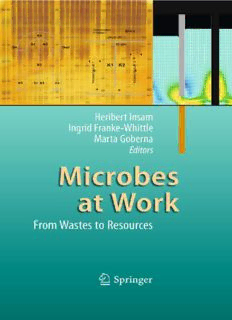Table Of ContentMicrobes at Work
Heribert Insam Ingrid Franke-Whittle
l l
Marta Goberna
Editors
Microbes at Work
From Wastes to Resources
Editors
Prof.Dr.HeribertInsam Dr.IngridFranke-Whittle
Universita¨tInnsbruck Universita¨tInnsbruck
Inst.Mikrobiologie Inst.Mikrobiologie
Technikerstr.25 Technikerstr.25
6020Innsbruck 6020Innsbruck
Austria Austria
[email protected] [email protected]
Dr.MartaGoberna
Universita¨tInnsbruck
Inst.Mikrobiologie
Technikerstr.25
6020Innsbruck
Austria
[email protected]
ISBN:978-3-642-04042-9 e-ISBN:978-3-642-04043-6
DOI10.1007/978-3-642-04043-6
SpringerHeidelbergDordrechtLondonNewYork
LibraryofCongressControlNumber:2009938021
#Springer-VerlagBerlinHeidelberg2010
Thisworkissubjecttocopyright.Allrightsarereserved,whetherthewholeorpartofthematerialis
concerned,specificallytherightsoftranslation,reprinting,reuseofillustrations,recitation,broadcasting,
reproductiononmicrofilmorinanyotherway,andstorageindatabanks.Duplicationofthispublication
orpartsthereofispermittedonlyundertheprovisionsoftheGermanCopyrightLawofSeptember9,
1965,initscurrentversion,andpermissionforusemustalwaysbeobtainedfromSpringer.Violations
areliabletoprosecutionundertheGermanCopyrightLaw.
Theuseofgeneraldescriptivenames,registerednames,trademarks,etc.inthispublicationdoesnot
imply,evenintheabsenceofaspecificstatement,thatsuchnamesareexemptfromtherelevantprotec-
tivelawsandregulationsandthereforefreeforgeneraluse.
Coverdesign:WMXDesignGmbH,Heidelberg,Germany
printedonacid-freepaper
SpringerispartofSpringerScience+BusinessMedia(www.springer.com)
Preface
Variousapproachestoenvironmentallysoundwaste-treatmentprocesseshavebeen
designedanddevelopedinrecentyears.Biologicaltreatmentsarethebestalterna-
tive to the disposal of the putrescent fraction of separately collected biowaste, as
thesetechnologiesmaximizerecyclingandrecoveryofthewastecomponents.
Composting, the biological degradation of organic wastes to humus, saves
naturalresources,andtheapplicationofcompostsmayenhancetheorganiccarbon
status in soil, thereby contributing to a decrease in atmospheric CO . The use of
2
compost is also known to exert positive effects on the physical properties of soil,
suchasincreasingthesoilporosity,enhancingmicrobialactivitiesandtheabilityto
suppressplantdiseases,andthereforereducingtheneedforpesticides.
Anaerobic digestion is the biological process for the decomposition of organic
wasteintheabsenceofoxygen.Thisprocessconvertstheorganicpartofthewaste
into stable substances through a number of complex bacterial reactions and pro-
duces biogas, an important asset in times of decreasing fossil fuel supplies and
concernsaboutrisesingreenhousegases,aswellasananaerobicsludgethatcanbe
used as a fertilizer and for soil conditioning. Anaerobic digestion is increasingly
replacingaerobicdegradationasatreatmentprocess,sincetheadditionalbenefitof
gainingrenewableenergyisconsideredmoreandmoreimportant.
Microorganismsplayakeyroleinbothaerobicandanaerobicdigestionprocess-
es of organic wastes. Until the last decade, there had been only limited research
concerning the structural and functional diversity of the microbial communities
involved in these digestion processes. The development of molecular tools has
however allowed more detailed investigations into the microbial communities
responsiblefortheconversionofthewastestoresources,allowingabetterunder-
standingofthedynamicsofthemicrobialplayersinvolved.
‘Microbesatwork:Fromwastestoresources’comprises16chaptersthatdiscuss
variousaspectsofdigestionprocesses.Inthefirstchapters,contributionsfocuson
thecommunitiesofmicroorganismsinvolvedindifferenttypesofwastetreatment,
including composting, vermicomposting, and anaerobic digestion. The chapters
that follow discuss the presence of ‘good’ and ‘bad’ microorganisms in the final
v
vi Preface
product. The chapters occurring towards the end of the book present application-
basedstudiesorinvestigatetheeffectsofapplicationofatreatedwasteonthesoil
microbialcommunity.Hopefully,thereaderwillbeadequatelyinformedaboutthe
state-of-the-artofbiologicalwastetreatment,and,withthehelpofthefinalchapter,
willlearntobetterexploitmicrobialmetabolicpathways.
The editors acknowledge the assistance of the many reviewers in editing the
different book chapters and thank Springer Verlag for the excellent co-operation
duringtheproductionofthebook.
Innsbruck HeribertInsam
September2009 MartaGoberna
IngridFranke-Whittle
Contents
1 MicrobesinAerobicandAnaerobicWasteTreatment ................ 1
HeribertInsam,IngridFranke-Whittle,andMartaGoberna
2 RecentDevelopmentsinBio-EnergyRecoveryThrough
Fermentation ............................................................. 35
R.Braun,B.Drosg,G.Bochmann,S.Weiß,andR.Kirchmayr
3 SyntrophicCommunitiesinMethaneFormationfromHigh
StrengthWastewaters ................................................... 59
CarolineM.Plugge,JulesB.vanLier,andAlfonsJ.M.Stams
4 BiogasTechnology–ControlledGasFlowforEnhancedMixing,
Heating,andDesulfurization ........................................... 79
BernhardWettandHeribertInsam
5 Vermicomposting:EarthwormsEnhancetheWorkofMicrobes ... 93
JorgeDom´ınguez,ManuelAira,andMar´ıaGo´mez-Brando´n
6 CompostMicrobialActivityRelatedtoCompostStability .......... 115
AnCeustermans,JozefCoosemans,andJaakRyckeboer
7 UtilityofMolecularToolsinMonitoringLargeScale
Composting .............................................................. 135
JenniHultman,JukkaKurola,AijaRainisalo,MerjaKontro,
andMartinRomantschuk
8 ProductionandUtilizationofSuppressiveCompost:
Environmental,FoodandHealthBenefits ............................ 153
MarcodeBertoldi
vii
viii Contents
9 SanitationbyComposting .............................................. 171
Bjo¨rnVinnera˚s,F.Agostini,andHakanJo¨nsson
10 MicrobialAntagonistsinAnimalHealthPromotion
andPlantProtection .................................................... 193
VivianaKlose,MarkusNeureiter,MichaelaMohnl,
HerbertDanner,andChristinaDonat
11 InteractionsBetweenBeneficialandHarmfulMicroorganisms:
FromtheCompostingProcesstoCompostApplication ............. 213
JacquesG.Fuchs
12 CompostMicrobialPopulationsandInteractionswithPlants ...... 231
DrorMinz,StefanJ.Green,MayaOfek,andYitzhakHadar
13 SoilDegradationandRehabilitation:Microorganismsand
Functionality ............................................................ 253
F.Bastida,T.Herna´ndez,andC.Garc´ıa
14 DoCompostsAffecttheSoilMicrobialCommunity? ................ 271
BrigitteA.Knapp,MargaritaRos,andHeribertInsam
15 ProductionandApplicationofBioorganicFertilizersforOrganic
FarmingSystemsinThailand:ACaseStudy ......................... 293
N.Teaumroong,C.Wanapu,Y.Chankum,W.Arjharn,S.Sang-Arthit,
K.Teaimthaisong,andN.Boonkerd
16 Challenges,OptionsandFutureResearchNeeds .................... 313
JuanLuisTurrion-GomezandBlancaAntizar-Ladislao
Index .......................................................................... 323
Chapter 1
Microbes in Aerobic and Anaerobic
Waste Treatment
HeribertInsam,IngridFranke-Whittle,andMartaGoberna
Abstract Thischaptergivesanoverviewofthematerialsandchemicalcompounds
that are the subject of microbial degradation under both aerobic and anaerobic
conditions.Bacteria,fungi,andarchaeathatareresponsiblefordegradationorfor
specific phases of a degradation process are indicated. Special attention is given
to two major processes of organic waste recycling involving microorganisms –
compostingandanaerobicdigestionforbiogasproduction.Theuseofclassicaland
noveltoolsforinvestigatingtheinvolvedmicrobiotaisdiscussed.Also,aspectsof
nutrient and greenhouse gas balances are addressed. The chapter concludes by
emphasizing that with microbial action, an environmentally sound recycling of
organicresiduesispossible,andthatthisshouldbeencouragedbywastemanage-
mentpolicies.
Contents
1.1 Introduction ............................................................................... 2
1.2 TheSubstrates ............................................................................ 2
1.2.1 Lignin ..............................................................................2
1.2.2 Cellulose ...........................................................................3
1.2.3 Hemicelluloses(Xylan,Pectin,Starch) ............................................3
1.2.4 MicrobialCellWallComponents:MureinandChitin .............................4
1.3 AerobicorAnaerobicDegradation:Four-PhaseMicrobiallyDrivenProcesses .......... 4
1.3.1 Composting ........................................................................4
1.3.2 AnaerobicDigestion ...............................................................8
1.4 ApplicationofMolecularToolsforStudying
MicrobialCommunityDiversityinCompostsandAnaerobicSludges .................. 16
1.5 CarbonandNutrientBalance ............................................................ 23
1.6 Conclusions .............................................................................. 24
References ......................................................................................24
H.Insam(*),I.Franke-Whittle,andM.Goberna
Universita¨tInnsbruck,Institutfu¨rMikrobiologie,Technikerstrasse25d,6020Innsbruck,Austria
e-mail:[email protected];[email protected];[email protected]
H.Insametal.(eds.),MicrobesatWork, 1
DOI10.1007/978-3-642-04043-6_1,#Springer-VerlagBerlinHeidelberg2010
2 H.Insametal.
1.1 Introduction
Duringbiodegradation,allorganicmatterpassesthroughthemicrobialdecom-
poserpool.Thisisthereasonwhymicroorganismshaveakeyroletoplayinthe
recycling of matter, and why we need to facilitate their activity in order to
ensure faster and proper work being done. However, very often it is the engi-
neers who design the waste treatment facilities who are driven by empirical
experience,architecturalconcepts,andpoliticaldecisionsratherthantheneeds
ofthemicrobes.
Microbiologistsresponsibleforthewell-beingof“theworkers,”i.e.,microbes,
in awaste treatment plant would come up with a set of prerequisites that mustbe
met for the best possible working conditions. There are essentially two different
classesofworkers,thosethatpreferfreshairwithalotofoxygen(thecomposters)
andthosethatlikeitoxygen-free(thedigesters).Insomecases,however,weneed
bothofthem,andweneedtoofferworkingconditionsthatareacceptableforeach
group.Thisstartswiththeappropriatesubstrates.
1.2 The Substrates
Essentially,alldegradablesubstratesareeitherofplant,animal,ormicrobialorigin.
Generally, plant materials comprise the largest fractions, whereas animal tissues
and microbial components are only minor fractions of any mixture. The major
naturalcompounds,aswellastheirpotentialdegradability,havebeensummarized
byInsamanddeBertoldi(2007).
1.2.1 Lignin
Amajorstructuralcomponentofplantsisligninwhichmaycompriseupto30%of
wood. While the number of different monomers (derivatives of phenylpropane,
mainly coniferyl alcohol) is small, the extraordinary variety of bondings among
themmakedegradationadifficulttask.Thus,lignindecompositionisusuallyofthe
co-metabolictype,astheenergyyieldfromlignindegradationisnegligible.Lignin
isprimarilydegradedbyfungithatareoftenpathogenswhichalsothriveonliving
plants. Lignin-degrading fungi are known as white-rot fungi, like Trametes versi-
color (Turkey Tail), or Stereum hirsutum (False Turkey Tail). They degrade the
ligninandleavebehindthecellulosiccomponents.Somefungi,suchasPleurotus
ostreatus,co-degradecelluloseandlignin.
Description:Among the goals of environmentally sound waste treatment is the recycling of organic wastes. The most practiced options are composting and anaerobic digestion, both processes being carried out by microorganisms. This book provides an overview of the various ways microbes are doing their job and give

